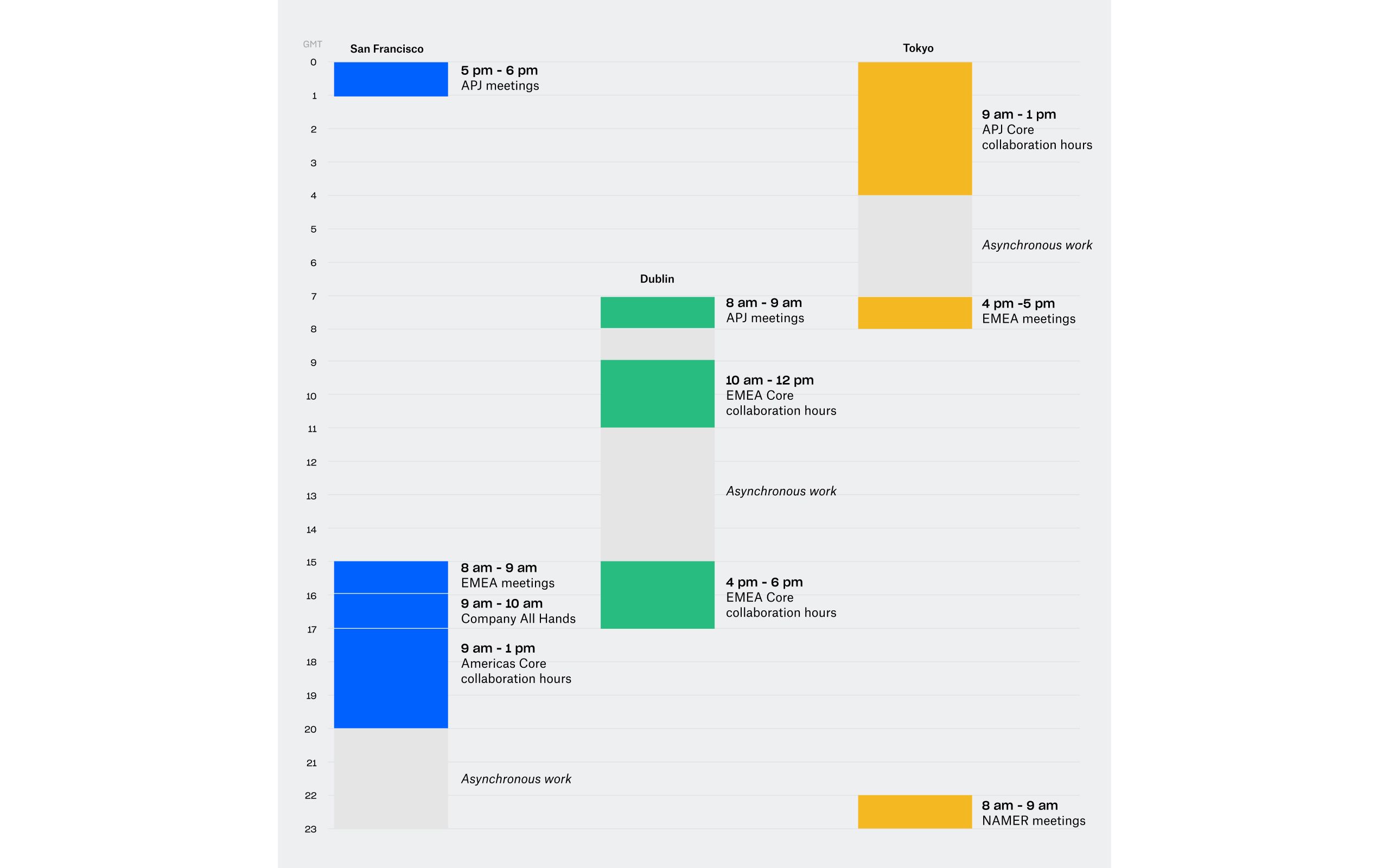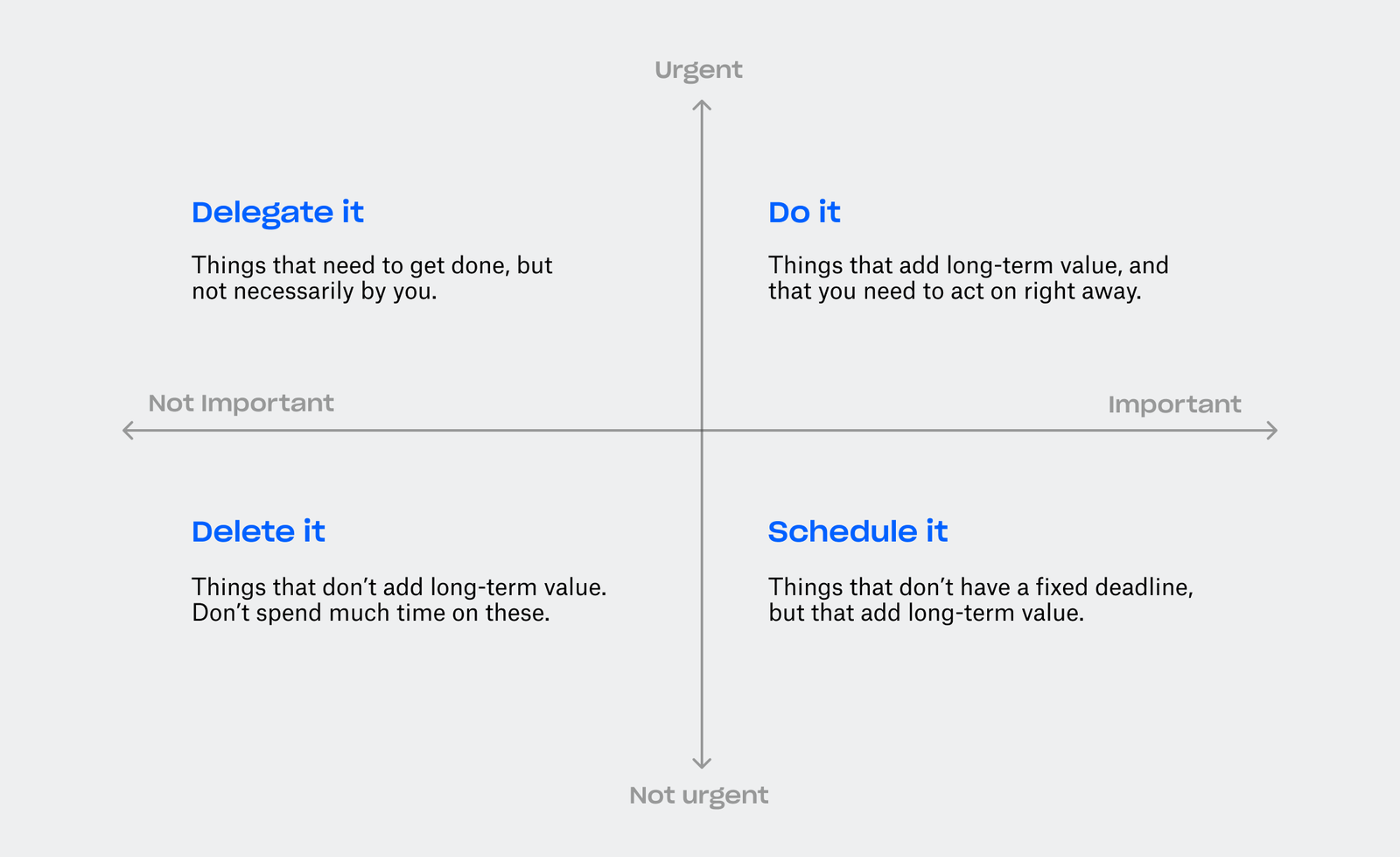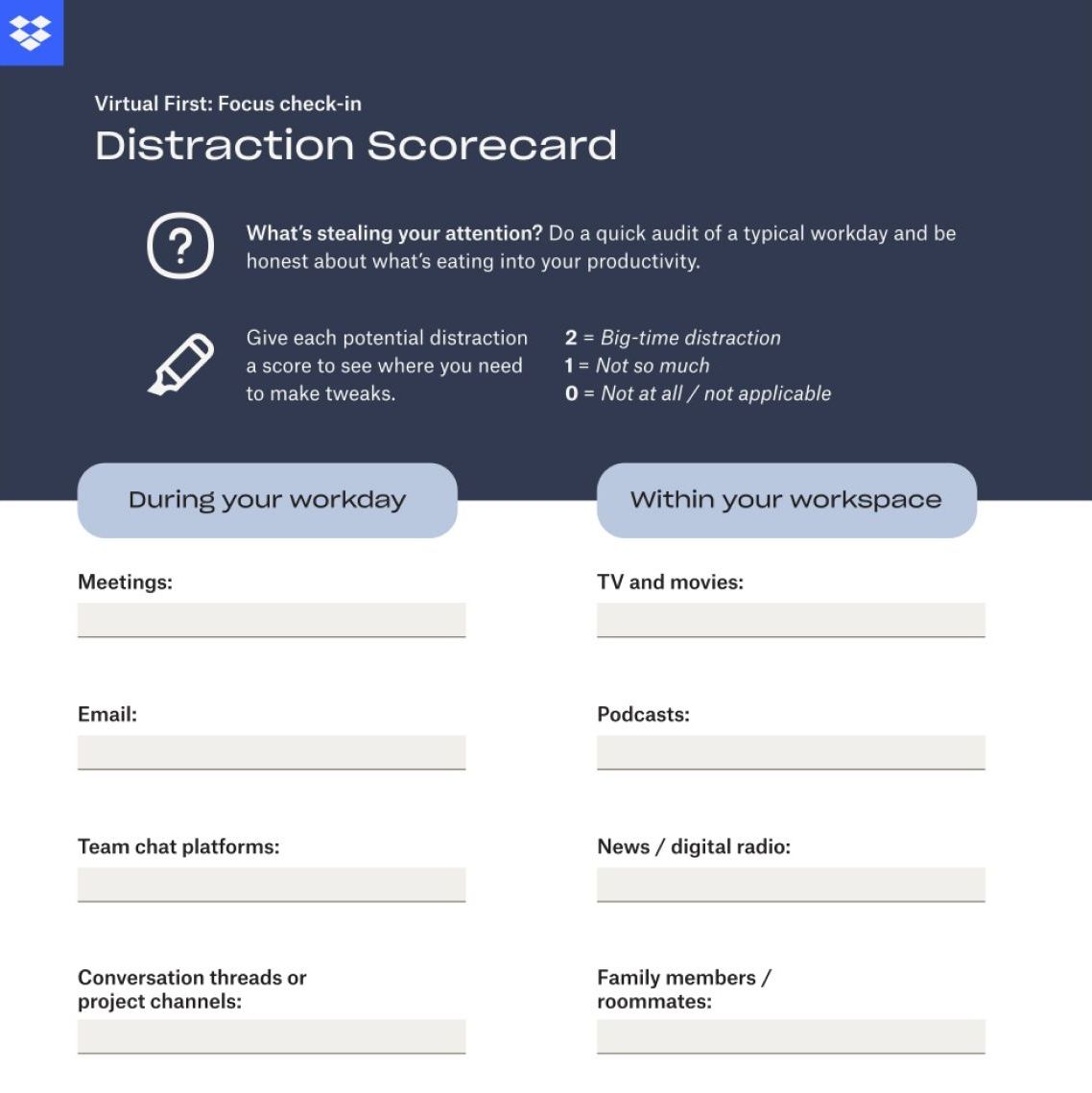Table of contents
- Decide cuándo colaborar
- Identifica qué entornos os ayudan a ti y a tu equipo a concentraros
- Prioriza de forma clara las tareas
- Quédate con lo que funciona
- Invierte en la productividad de tu equipo
- Prueba los descansos autorregulados y las pausas “Pomodoro”
- Elabora un plan
- Crea sistemas de rendición de cuentas
- Mantente físicamente activo
- Autoevalúate periódicamente
Para comprender mejor los desafíos a los que se enfrentan los trabajadores del conocimiento hoy en día, elaboramos un estudio llamado “In search of lost focos (En busca del foco perdido)” junto con Economist Impact. Los datos que recopilamos reforzaron la idea de que, con todas las distracciones que podemos enfrentar en el trabajo moderno, necesitamos descubrir cómo mantener a nuestros equipos productivos.
Sin embargo, apoyar la productividad de cada uno puede resultar complicado si los miembros del equipo trabajan en diferentes ubicaciones. Esto hace que todo, desde el establecimiento de objetivos hasta la priorización, sea más desafiante, por lo que tuvimos que crear sistemas para apoyar a nuestros equipos en esas áreas.
Nuestra experiencia con Virtual First significa que hemos tenido que convertirnos en expertos en mantenernos productivos de forma remota. Para compartir lo que aprendimos, hemos creado esta lista de los mejores consejos que ayudan a nuestro equipo a mantenerse productivo.
1. Decide cuándo colaborar
En Dropbox, utilizamos horas centrales de colaboración, bloques de cuatro horas en los que realizamos todas nuestras reuniones. Al designar ciertas horas para las llamadas, puede garantizar que todos estén disponibles para sincronizarse, independientemente de su zona horaria.
Además, sufrimos fatiga por Zoom como todo el mundo, por lo que minimizar las reuniones y tener horas libres de reuniones ha ayudado a mantener nuestros cerebros frescos. Significa que tenemos tiempo para trabajar en profundidad y colaborar.
Establecemos diferentes bloques de tiempo según el área para adaptarnos a las diferentes zonas horarias y al mismo tiempo dejar suficiente superposición para que podamos reunirnos sin importar dónde estemos.

Intentamos mantener nuestra comunicación en modo asincrónico por defecto. Dependemos en gran medida de Slack y el correo electrónico para comunicarnos. Pero reducir las reuniones en persona puede no ser suficiente. Los correos electrónicos y mensajes privados constantes pueden genera muchas distracciones, especialmente si tu equipo intenta responderlos de inmediato. De hecho, las investigaciones indican que puede llevar hasta ocho minutos volver a una tarea después de responder a un solo mensaje instantáneo. Descubrimos que los mensajes de chat improductivos son la principal causa de pérdida de concentración en general.
Lo que hace que la comunicación sea verdaderamente asincrónica es la expectativa de poder responder en sus propios tiempos, sin ninguna de las presiones que el nombre “mensajería instantánea” podría implicar. De esa manera, cada miembro del equipo sabe que tendrá horas de trabajo intenso cada día.
Reglas y pautas como estas pueden conformar rituales útiles que permitan a tu equipo establecer sus ritmos de trabajo.
2. Identifica qué entornos os ayudan a ti y a tu equipo a concentraros
Al adoptar Virtual First, nuestros equipos dispersos tienen un mayor control sobre su entorno de trabajo, lo que ayuda a mejorar su productividad y bienestar en el trabajo. Animamos a nuestros equipos a que determinen sus preferencias laborales proporcionándoles una “hoja para trabajar desde casa”.

Todos responden previamente y luego nos reunimos para discutir cómo prefieren trabajar los diferentes miembros del equipo. Esto no solo permite que las personas compartan sus preferencias, sino que también es un gran ejercicio para estrechar lazos en el equipo que ayuda a que todos se conozcan.
Después de analizar las respuestas de la hoja de trabajo, aprendimos qué cuatro factores fundamentales son los que más afectan la productividad:
Privacidad: ¿Pueden concentrarse más fácilmente en una cafetería donde están rodeados de otras personas? ¿O hacen más trabajo aislados en su oficina en casa?
Ruido de fondo: ¿Siempre les gusta poner música que les mejore el ánimo mientras trabajan? ¿O prefieren un silencio sepulcral, tal vez con auriculares con cancelación de ruido para ayudar?
Comodidad: ¿Tienen una mesa ajustable y una silla con apoyo en la espalda? ¿O prefieren trabajar de pie y tienen el equipamiento necesario para ello? ¿Cuentan con soportes para las muñecas que eviten lesiones?
Diseño: ¿Prefieren tener una decoración personal en la oficina como plantas, obras de arte o una taza colorida? ¿O quieren una mesa vacío sin posibles distracciones?
Ayudar a los miembros de tu equipo a diseñar su entorno de trabajo basándose en este autoconocimiento les ayudará a sentirse relajados, cómodos y concentrados. Pero, a veces, ni siquiera la oficina mejor equipada ni el plan mejor pensado son suficientes para mantenernos por el buen camino. Necesitamos ayuda para seguir siendo responsables.
3. Prioriza de forma clara las tareas
En una entrevista con Dropbox, Oliver Burkeman, autor de Cuatro mil semanas: Gestión del tiempo para mortales, nos dijo que muchas personas creen que “Tiene que haber una manera para ser cien por ciento el trabajador perfecto y cien por ciento la persona perfecta con una vida fuera del trabajo”. Pero, como señala Burkeman, “los porcentajes no funcionan así”.
Nos enseñó que, como nuestro equipo trabaja en remoto, trabajamos de forma independiente, al igual que en nuestras horas de trabajo asincrónicas. Eso significa que necesitamos disciplina, conocimiento y herramientas para administrar bien nuestro tiempo. Priorizar lo que hacemos en el trabajo y en nuestra vida personal es la primera herramienta para garantizar que nuestro trabajo sea productivo y tenga impacto. Además, ayuda a lograr el equilibrio saludable que necesitamos para sentirnos concentrados y realizados.
Para quienes trabajamos en remoto, priorizar las tareas resulta especialmente importante porque no siempre podemos pedir aclaraciones a nuestros compañeros en tiempo real y dependemos los unos de los otros. Entender que nuestro trabajo afecta a los demás miembros del equipo y, en consecuencia, al resultado, nos ayuda en el proceso de priorización de tareas.
También utilizamos la matriz de Eisenhower. Esta herramienta sirve para categorizar las tareas a lo largo de una cuadrícula de cuatro lados:
Urgente e importante: realiza esas tareas lo antes posible.
Importante pero no urgente: delega esas tareas.
Urgente pero no importante: programa esas tareas para más tarde.
Ni urgente ni importante: no te centres en esto.
El último punto resulta especialmente crucial a la hora de establecer prioridades. Asegúrate de que tu equipo sabe que no debe tratar cada tarea como si estuviera en la parte superior de su lista de tareas pendientes. Decir no puede ser un desafío, por eso es útil tener un plan para las tareas menos urgentes. Por ejemplo, pueden delegar tareas de las que no tengan que ocuparse personalmente.
Si un miembro del equipo tiene una reunión no esencial, puede delegarla a alguien que asista o usar una herramienta para asegurarse de obtener la información que necesita. Los programas de grabación y transcripción de reuniones como Otter pueden resumir los puntos clave de una reunión y aclarar si alguna parte es relevante para quienes no han asistido. Enseña a tu equipo estas habilidades organizando talleres y proporcionando recursos sobre gestión eficaz de tareas, como nuestra "Hoja sobre cómo priorizar las tareas en el trabajo".
Con un plan establecido y elementos de acción definidos, es hora de organizar las comunicaciones de tu equipo.
4. Quédate con lo que funciona
Descubrimos que animar a nuestros equipos a crear rituales diarios les ayuda a mantener una agenda consistente y mejora la productividad, y estudios recientes respaldan nuestras conclusiones. Aquí hay algunos tipos de rituales que nos han funcionado:
Proporcionar recursos para apoyar una mejor concentración. En nuestro ejercicio “Concéntrate más durante tu jornada laboral” del kit de eficacia, explicamos cómo analizar las distracciones y evitarlas. La hoja de puntuación de distracciones del recurso es un excelente lugar para comenzar, donde tu equipo puede registrar todas las distracciones que encuentra. Luego, pueden seguir la guía para crear pequeños rituales, como poner los teléfonos en modo No molestar durante horas concretas.
Practicar la meditación para el bienestar psicológico. Recomendamos realizar breves sesiones de meditación de 60 segundos al comenzar algunas de vuestras reuniones. Eso pone a todos en el estado mental adecuado para ser creativos y abiertos a las ideas, sin mencionar que mejora nuestro estado de ánimo cuando tenemos un día estresante.
Pero hay aún más formas de contribuir a la productividad de tu equipo.

5. Invierte en la productividad de tu equipo
A veces, aumentar la productividad requiere una inversión inicial de tiempo o dinero. Por eso nos aseguramos de que nuestro equipo disponga de las herramientas que solicita. No solo ahorra tiempo. Les hace sentirse valorados y escuchados.
Por ejemplo, cuando tu equipo dice: "Tiene que haber una manera de automatizar esto", generalmente vale la pena que inviertan tiempo desde el principio para descubrir cómo hacerlo. Una forma de lograrlo es crear franjas horarias designadas para el desarrollo profesional que mejore la productividad. También puedes organizar talleres durante esos espacios para que tu equipo mejore las habilidades principales que les gustaría desarrollar.
En Dropbox, además, utilizamos herramientas de colaboración como Dash para buscar, acceder y compartir nuestros materiales de trabajo desde un único panel: un gran ahorro de tiempo y un truco para mejorar la productividad. Para usarlo, simplemente escribe lo que estás buscando, como "gasto en redes sociales", y buscará documentos relevantes en todas tus carpetas, aplicaciones y nubes.
Proporciona todos los documentos relevantes y un resumen basado en su término de búsqueda, extrayendo información de los documentos y ahorrándote el tiempo que te llevaría buscar en cada uno de ellos.
Tan importante como las herramientas tecnológicas es proporcionar el equipamiento físico que tu equipo necesita para trabajar cómodamente, como un segundo monitor, que puede marcar la diferencia en términos de productividad. Si ofreces una ayuda, como nuestra asignación de beneficios, tu equipo podrá invertirla en cursos de desarrollo o equipos para el lugar de trabajo. Esa inversión vale la pena cuando algo tan simple como un monitor significa que pueden trabajar más rápido.
6. Prueba los descansos autorregulados y las pausas “Pomodoro”
En nuestro estudio sobre concentración y trabajo remoto, descubrimos que el 63 % de los trabajadores en remoto sienten que deben estar disponibles todo el tiempo. No queremos que nuestros equipos distribuidos sufran ese tipo de presión: una de las mejores partes del trabajo en remoto es la libertad.
Por eso utilizamos timeboxing, la práctica de dividir una tarea en unidades discretas de tiempo y hacer descansos entre ellas. Hacer descansos entre tareas como esta nos funciona tan bien que incluso hemos diseñado nuestro propio ejercicio personal de timeboxing para ayudar a otros a hacer lo mismo.
Dos de los sistemas más populares para hacer descansos y timeboxing son los descansos autorregulados y las pausas “Pomodoro”. La forma en que cada persona hace sus descansos es algo muy personal. Sin embargo, una comparación de ambos realizada por la Sociedad Británica de Psicología determinó que los descansos autorregulados conducen a unos niveles más bajos de concentración y motivación.
Al fin y al cabo, se trata de una cuestión de preferencia personal, pero animamos a las personas a probar la técnica Pomodoro, donde se trabaja en intervalos enfocados:
25 minutos de trabajo profundo
5 minutos de descanso
Repetición
Descanso de 15 a 30 minutos después de cuatro ciclos
Al estructurar tus descansos dentro de una jornada laboral, tu mente estará más alerta y serás más consciente de la gestión del tiempo. Pero es más fácil aprovechar al máximo tu tiempo de concentración cuando estás en un entorno que lo facilita.
7. Elabora un plan
Nadie es perfecto Al igual que el 99 % de los estadounidenses, luchamos contra la procrastinación. Pero, de acuerdo con nuestra experiencia, una de las mejores formas de contraatacar es elaborar un plan sólido para dividir el proyecto en tareas más pequeñas. Esto ha sido especialmente importante para nuestro equipo distribuido ya que cada miembro gestiona sus tareas y su tiempo.
Dividir una tarea grande o un trozo de información en partes más pequeñas se llama fragmentación, e incluso puede ayudarte a recordar todo lo que tienes que hacer. Un estudio sobre métodos de fragmentación demostró que dividir una gran pieza de información, como un número, en varias más pequeñas puede ayudar a recordarlo todo.
A continuación presentamos algunos pasos prácticos que utilizamos cuando asumimos un proyecto de gran envergadura:
- Define el objetivo: cuando tu equipo comience el proyecto, identifica su efecto previsto. ¿Aumentar los ingresos? ¿Reducir costos de infraestructura? ¿Crear un producto nuevo e innovador?
- Establece hitos: planifica los hitos que el equipo deberá alcanzar para lograr ese objetivo. Pueden ser cualquier cosa, desde objetivos de ventas individuales hasta metas de equipo en torno a la creación de características específicas para un producto.
- Desglósalo: ahora, puedes ser aún más granular y dividir los hitos en pasos más pequeños y viables que cada miembro del equipo puede seguir para alcanzarlos.
- Prioriza: concéntrate primero en las tareas de alto impacto. Profundizaremos en esto más adelante, pero una cosa que debes recordar al priorizar la tarea de un equipo es si alguien está bloqueado. Si el progreso de una persona depende de que otra complete una tarea específica, prioriza esa tarea y brinda a la persona a cargo de su ejecución la ayuda que necesite para completarla rápidamente.
Una vez que tu equipo haya decidido qué necesita hacer y en qué orden, podrá decidir qué reuniones y tareas requieren descansos y cuáles puede agrupar una tras otra. Esta técnica resulta especialmente útil para crear bloques de tiempo eficientes en tu calendario. Para obtener algunos consejos sobre cuándo agrupar tus reuniones y tareas y cuándo separarlas con descansos, echa un vistazo a nuestro ejercicio personal de reuniones por lotes y con pausas.
Una vez que tengas un plan, es hora de ser un poco más granular y determinar cómo lo vas a ejecutar.
8. Crea sistemas de rendición de cuentas
Todos debemos responsabilizarnos de nosotros mismos (o pedirle a alguien que lo haga). Nos mantiene por el buen camino y nos ayuda a alcanzar nuestras metas. Resulta especialmente útil en un entorno distribuido, donde la supervisión puede ser limitada. A continuación mostramos algunos sistemas que hemos aplicado a lo largo de los años y que han funcionado para nuestro equipo:
- Autorresponsabilidad: haz que tu equipo establezca recompensas personales por alcanzar objetivos, como darse el gusto de hacer algo agradable (como cenar con un amigo). Por el contrario, si no cumplen con un plazo, deberían tener un plan para compensarlo sin sobrecargarse.
- Apoyo entre pares: estableced socios responsables entre los compañeros. Los registros periódicos pueden mantener a todos motivados y encaminados.
- Supervisión gerencial: planificad revisiones periódicas del progreso y fijad objetivos juntos. Esto proporciona orientación y validación externa para los empleados.
En los centros de trabajo distribuidos, es fundamental tener intención con respecto a estos sistemas. En una entrevista con Dropbox para Remotely Curious, la profesora Gloria Mark, experta en concentración de la Universidad de California, Irvine, añadió que los trabajadores en remoto deben fijar metas emocionales (cómo quieren sentirse en un día determinado) y proyectar objetivos a diario para mantenerse responsables a nivel personal y profesional.
Tu equipo puede plantearse preguntas como “¿Qué quiero lograr?” y “¿Cómo quiero sentirme?” al comenzar su jornada. El Dr. Mark lo explica así: “Hacerse estas preguntas al comienzo del día ayuda a las personas a mantenerse enfocadas, ya que pone los objetivos en primer plano y sirve para dirigir la atención”.
9. Mantente físicamente activo
Hemos descubierto que la actividad física y el ejercicio son muy eficaces para mantenernos motivados y concentrados durante todo el día. No solo nos hacen sentir más productivos y llenos de energía, sino que también son una excelente manera para que los equipos se conecten en torno a algo saludable y divertido. En una oficina, puede mantenerse cierta actividad natural moviéndose entre las salas, pero cuando se trabaja en remoto resulta difícil encontrar tiempo para la actividad física.
Por eso nos encanta programar reuniones “Meet & Move”, donde animamos a los participantes a moverse un poco mientras charlamos. Nos impiden realizar varias tareas a la vez y nos dan la oportunidad de hacer una actividad física mientras estamos trabajando.
No obstante, hay varios factores que deben tenerse en cuenta. Primero, querrás elegir una reunión que se adapte bien a tus planes. Si estás haciendo una presentación o utilizando un elemento visual, moverse será difícil. En cambio, una reunión más informal o individual podría ser una mejor opción.
También deberías planificar tu ruta hacia algún lugar sin demasiado ruido de fondo, como un parque tranquilo en lugar de la acera de una calle concurrida. Incluso puedes caminar de un lado a otro por tu propia casa para disfrutar de tranquilidad y comodidad. No importa cómo lo hagas, un poco de movimiento puede tener importantes beneficios: un estudio descubrió que solo una hora de ejercicio a la semana puede mejorar la salud física y el rendimiento laboral.

Si bien las semanas de bienestar solo ocurren una vez al año, las sesiones pueden enseñar a los usuarios de Dropbox a hacer de la actividad física un elemento más constante de sus vidas. A continuación se muestran algunas de nuestras formas favoritas de seguir moviéndonos durante todo el año:
Reuniones caminando: convierte una llamada de Zoom en una reunión caminando para moverte mientras hablas.
Estaciones de trabajo activas: considera utilizar un escritorio de pie o una plataforma para caminar debajo del escritorio. Dropbox, por ejemplo, fomenta las configuraciones de escritorios activos y ayuda a cubrir el costo con nuestra asignación de beneficios como parte de su asignación de beneficios.
Paseos diarios: si tu equipo trabaja desde casa, puedes animar a sus miembros a dar un paseo para enmarcar su jornada laboral, simulando un desplazamiento diario al trabajo.
Clases: anima a tu equipo a apuntarse a esa clase de fitness del mediodía y añadir algo de movimiento a sus días.
Para ayudar a los miembros de nuestro equipo a aprovechar al máximo su tiempo de actividad física, les animamos a planificarlo en función de sus niveles de energía diarios. Quienes encuentren la actividad física energizante pueden realizarla antes de realizar su trabajo profundo. Aquellos a quienes les resulte agotadora, tal vez prefieran programarla para cuando hayan terminado su trabajo más pesado.
Hemos creado un ejercicio “Gestiona tus niveles de energía” como parte de nuestro kit de bienestar para ayudar a las personas a descubrir qué funciona mejor para ellos. Tanto tú como tu equipo podéis usarlo para registrar las horas en las que os sentís con mucha o muy poca energía y qué tareas rellenan o agotan vuestros niveles de energía. Armado con esa información, tu equipo podrá diseñar tus días en función de sus niveles de energía para asegurarse de que estén realizando sus tareas más complejas cuando tienen la energía para realizarlas.
10. Autoevalúate periódicamente
En Dropbox, nos gusta autoevaluar nuestra productividad revisando nuestros calendarios y evaluando hasta qué punto aprovechamos nuestro tiempo. Marcamos las reuniones y tareas en rojo, amarillo o verde para indicar si fue un uso malo, aceptable o bueno de nuestro tiempo. Luego utilizamos esa información para evaluar cómo podríamos ser más productivos. Eso ayuda a nuestros equipos a mantenerse por el buen camino y asegurarse de que están aprovechando su tiempo de la manera más eficaz posible.
Otro excelente truco para aumentar la productividad es identificar cuándo estás en un estado de flujo (caracterizado por un enfoque profundo y eficiencia) y evaluar las condiciones que te han ayudado a llegar hasta ahí. Esto puede ser un poco difícil de hacer, pero un estudio muestra que puede ser más fácil lograr un estado de flujo si minimizas las distracciones y fijas unos objetivos claros.
Incluso podrías desafiar a los miembros de tu equipo a anotar qué condiciones y objetivos les han ayudado a alcanzar sus estados de flujo en la última semana. Luego, organiza una reunión en la que puedan realizar una actividad de formación de equipos que revele las diferencias y similitudes en cómo cada miembro alcanza la máxima concentración.
La productividad en remoto es diferente para cada persona
Ayudar a tu equipo a alcanzar la máxima productividad en ubicaciones dispersas puede ser diferente a nivel individual; sabemos que es así para nuestro equipo. Por eso es necesario conocer a tu equipo y dotarlo de una amplia variedad de estrategias para ver qué le funciona mejor para cada persona.
Muchos de estos consejos se centran en ayudar a tu equipo a lograr y mantener el foco, pero como puede ver, esas no son las únicas formas de ayudar a realizar un trabajo impactante.
Para obtener más consejos sobre cómo mejorar la productividad y generar un impacto, escucha nuestro pódcast de Remotely Curious: Focus, con una experta en concentración, la profesora Gloria Mark.


